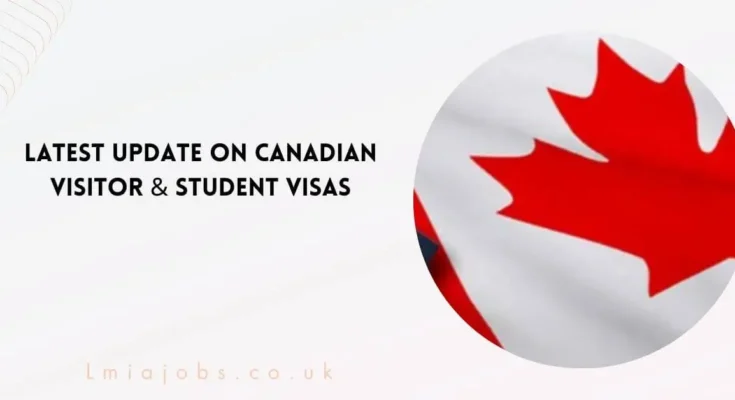Are you thinking about going to Canada to study or work? This piece goes into great detail about the most recent changes to Canadian visitor and student visas. It also gives you clear instructions on how to use the system.
What’s Changed?
New rules have been put in place for Canada’s tourist visa program. As more people use tourist visas to look for work, the government has made things stricter. This means applications will be checked more carefully, and there is a greater chance of being turned down.
Challenges for Visitors Seeking Work:
It can be hard to find work with a visitor visa. This is why:
- LMIA Requirements: A Labor Market Impact Assessment (LMIA) is needed for a lot of jobs in Canada. This is what companies have to do to show that they couldn’t find a permanent or citizen Canadian to do the job. Businesses usually choose to hire people who don’t need LMIA, which makes it hard for visitors to find jobs that meet this condition.
- Visa Delays: It takes longer to get a visitor visa now. This means you will have to wait a long time to find out if your application was accepted.
Tips for Visa Applicants:
- Be Patient. It may take a while to get a visa. Do not get upset and wait for an answer from Immigration, Refugees, and Citizenship Canada (IRCC).
- Plan Ahead: If you want to find work in Canada, you should start making plans before you leave your home country. Get in touch with people who can help you in Canada, look for work, and book your accommodations.
- Stay Informed: Things can change quickly, so find out about the newest visa rules and job market trends. For professional help, talk to immigration advisers or other experts.
Benefits of Canadian Visitor & Student Visas:
Benefits of Canadian Visitor Visas:
- Tourist Prospects: Canadian visitor visas afford individuals the opportunity to embark on cultural excursions and delve into the nation’s varied landscapes, natural marvels, and urban centers.
- Family Visits: Guests have the opportunity to reconnect with loved ones and acquaintances who are living in Canada, thereby nurturing intimate connections and forging enduring recollections.
- Business Opportunities: The visa grants authorization for visits that are in the course of business, including participation in conferences and meetings, as well as the investigation into prospective investment prospects in Canada.
- For educational objectives: Prior to applying for a study permit, prospective students may utilize visitor visas to conduct preliminary visits to Canadian universities, colleges, and other academic establishments.
- Cultural Exchange: By immersing themselves in Canadian language, customs, and culture, tourists can acquire a more profound appreciation for the nation and its people.
Benefits of Canadian Student Visas (Study Permits):
- Quality Education: Canada is host to universities, colleges, and institutions that are internationally renowned for their rigorous academic programs, state-of-the-art research facilities, and extensive range of academic disciplines.
- Employment Prospects: International students in possession of valid study permits are permitted to engage in part-time work during the course of their studies and full-time work during designated vacations. This flexibility enables them to supplement their income and acquire significant professional experience.
- Post-Graduation Work Permit (PGWP): The Post-Graduation Work Permit (PGWP) grants eligible graduates of Canadian institutions the opportunity to acquire Canadian work experience and establish pathways to permanent residency while working in Canada for a maximum of three years following the conclusion of their studies.
- Cultural Immersion: International students who choose to study in Canada are afforded the chance to fully engage with Canadian society, culture, and language, thereby promoting the development of cross-cultural appreciation and understanding.
- Safety and Quality of Life: Canada provides students with a multicultural, secure, and inclusive environment characterized by superior healthcare, social services, and living standards.
International Students and Job Seekers:
It’s hard for students, even those with study passes, to find part-time work. Companies like to hire foreigners with study permits because they don’t need LMIA, which makes the hiring process easy. This makes it even harder for tourists to find work.
Read Also: Plumbing Jobs In Canada For Foreigners Visa Sponsored
Before You Go:
Plan on taking a short trip to Canada? Here are some things to think about:
- Be Realistic —it’s not easy to find work with a visitor visa. Know what the problems are and how to solve them before you go.
- Make Smart Choices: Getting a visitor visa doesn’t mean you’ll get a job or be able to pay your bills. Prepare yourself and set reasonable goals.
Conclusion:
Canada’s program for tourist visas is always changing. Know what you’re doing and have a plan to follow it. Find out about the LMIA rules, the job market, and how to use your network to find possibilities. You can improve your chances of having a good trip to Canada by planning ahead and not giving up.
Frequently Asked Questions:
-
What is the new work permit in Canada?
IRCC introduced a new 2-year innovation work permit via the Global Hypergrowth Project. This new stream will allow eligible Canadian companies to hire foreign workers without an LMIA. Jobs under TEER 0, 1, 2, or 3 are classified as high-skilled.
-
What is the GIC amount for a Canadian student visa?
The new GIC amount for international students is CAD 20,635 (approximately INR 12,71,619). Earlier, the required GIC amount for Canada was CAD 10,000 (INR 616,244). This decision is driven by rising living expenses in the country and an increasing inflation rate.
-
What are the updates for IRCC?
IRCC will continue to prioritize applications in essential sectors such as agriculture, food processing, and health care, as well as work to keep our economy competitive by facilitating top talent, as announced in our Tech Talent Strategy.
